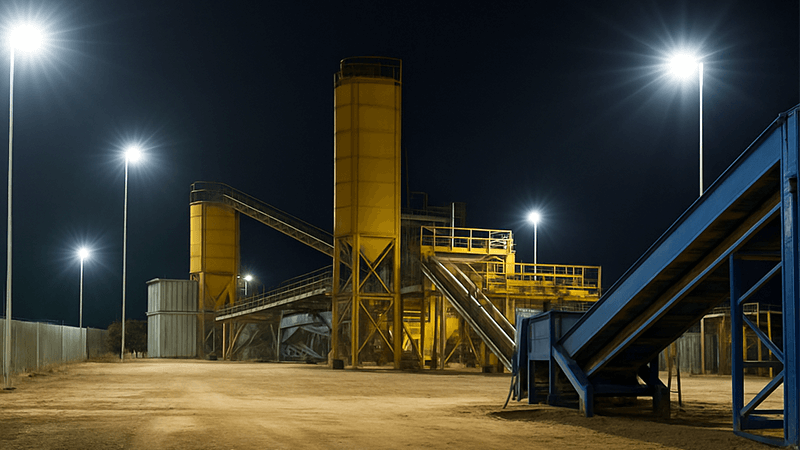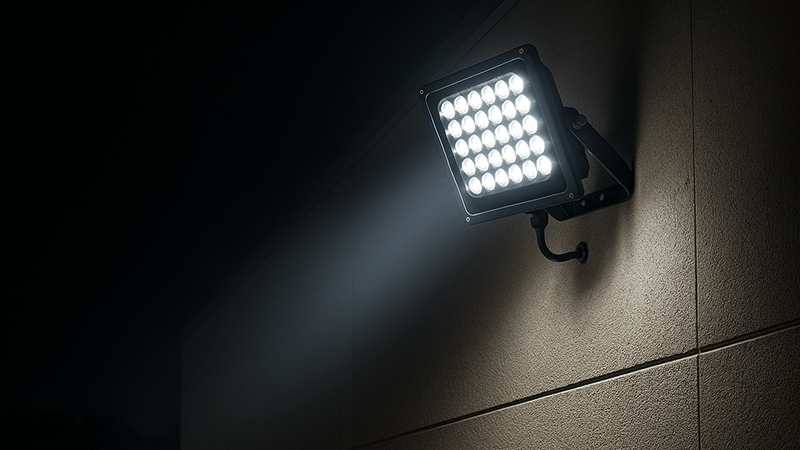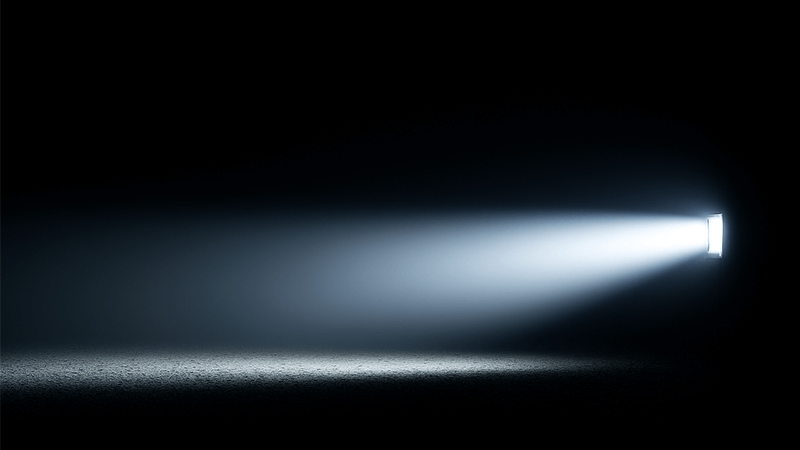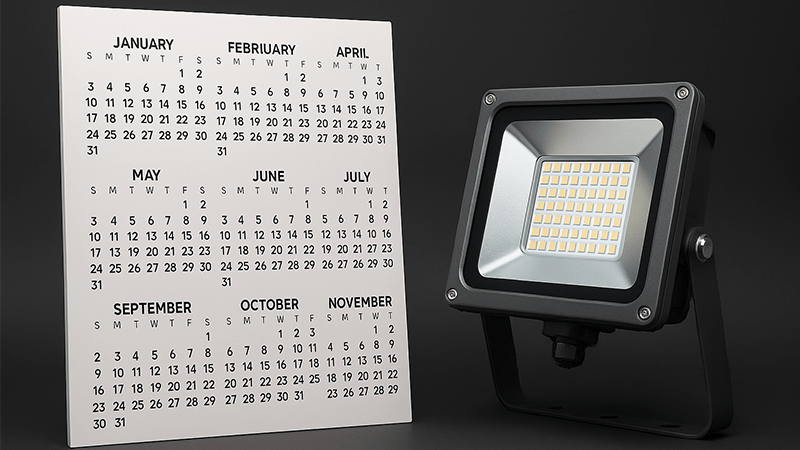Running an industrial site means you constantly worry about security. Dark perimeters and shadowy corners are an open invitation for trouble. But what if reliable lighting could erase those shadows?
LED floodlights improve security by providing bright, uniform illumination that eliminates hiding spots, deters intruders, and enhances CCTV camera performance. Their long lifespan and durability ensure your industrial site has constant, dependable protection.

I’ve been in the lighting business for a long time, starting on the factory floor. I’ve seen firsthand how the right lighting turns a vulnerable property into a secure one. Simply installing lights isn’t enough. You need to understand how they work to create a truly effective security system. Let’s dive into the specifics of what makes LED floodlights such a powerful tool for protecting your assets.
Are flood lights good for security?
You need strong security but are unsure if floodlights are the right choice. Making the wrong decision can be a costly mistake, giving you a false sense of safety.
Yes, floodlights are excellent for security. They cast a wide, powerful beam of light that deters potential intruders by making them highly visible. This removes hiding places and greatly increases the chance of detection, making them a core part of any security plan.

Floodlights work on a very simple principle: intruders fear being seen. I worked with a logistics client who was having major problems with theft from their shipping containers at night. The site was large and had many dark areas between the container stacks. After we installed a full system of high-lumen LED floodlights, their nighttime security incidents dropped by over 80%. It was a dramatic change. The power of bright, wide coverage provides several key benefits.
First is the psychological deterrent. Criminals operate in the dark because it provides cover. When you light up a facility, you take that cover away. They feel exposed and know that anyone, from a security guard to a passing car, can easily spot them. This simple fact is often enough to make them choose an easier, darker target.
Second is enhanced surveillance. Your security cameras can’t record what they can’t see. Good lighting is critical for CCTV systems to capture clear, usable footage. Modern LED floodlights with a high Color Rendering Index (CRI) show true-to-life colors. This means if an incident occurs, your cameras can capture accurate details like the color of a person’s clothing or their vehicle, which is vital for an investigation. Poor lighting just gives you grainy, black-and-white images that are often useless.
Finally, it improves safety for your own team. A well-lit industrial site is safer for employees who work night shifts. It reduces the risk of trips, falls, and accidents involving machinery or vehicles. This benefit for workplace safety goes hand in hand with security.
| Security Aspect |
Without Floodlights |
With LED Floodlights |
| Visibility |
Poor, many dark spots |
Excellent, uniform coverage |
| Deterrent Effect |
Low, invites intruders |
High, intruders feel exposed |
| CCTV Performance |
Grainy, unclear footage |
Clear, detailed, color footage |
| Personnel Safety |
High risk of accidents |
Low risk of accidents |
What type of lighting control is recommended for outdoor industrial lighting to enhance security?
Leaving your lights on all night is expensive and wastes energy. But turning them off completely puts your security at risk. It’s a tough problem for any facility manager.
Motion sensors and photocells (dusk-to-dawn sensors) are highly recommended. Motion sensors trigger lights when they detect movement, startling intruders and saving energy. Photocells automatically turn lights on at dusk and off at dawn, ensuring constant nighttime security without any manual work.

Static lighting is good, but intelligent lighting is better. Controls make your system more effective and efficient. In my experience, a combination of controls often provides the best balance of security and energy savings. The goal is to deliver the right amount of light, exactly when and where it is needed. Let’s look at the most common and effective options for industrial sites.
Photocells (Dusk-to-Dawn Sensors)
This is the simplest and most common control. A photocell detects ambient light levels. It automatically turns your floodlights on when the sun goes down and turns them off when it rises. This is a "set it and forget it" solution that guarantees your perimeter is never dark during nighttime hours. It eliminates human error, so you never have to worry about someone forgetting to turn the lights on.
Motion Sensors
Motion sensors add an active layer of security. The lights can be set to a low-level dim or completely off, then instantly switch to 100% brightness when motion is detected. This sudden burst of light is extremely effective at startling and scaring away potential trespassers. It also draws immediate attention to that specific area. For energy savings, this is a fantastic option, as the lights are only at full power when there is activity.
Smart Lighting Systems
The most advanced option is a networked smart lighting system. These systems connect your fixtures to a central controller, which can be managed from a computer or even a smartphone. This gives you ultimate control. You can create custom schedules, dim lights in certain zones, and receive instant alerts if a light is triggered by a motion sensor. You can also integrate the lighting with other security systems, like alarms and cameras, for a unified response. This is the future of industrial security lighting.
| Control Type |
Key Benefit |
Best Use Case |
| Photocell |
Automated, reliable nighttime operation |
Securing an entire perimeter from dusk to dawn. |
| Motion Sensor |
Active deterrent and energy savings |
High-risk zones, entry points, and low-traffic areas. |
| Smart System |
Total control, integration, and data |
Large, complex facilities requiring zoned control and monitoring. |
What is meant by the barrier potential of an LED?
You sometimes hear technical terms like "barrier potential" and feel confused. This kind of industry jargon can make it difficult to focus on what actually matters for your project’s security.
Technically, "barrier potential" is the minimum voltage needed for an LED to produce light. For a lighting buyer, this is an internal electronic detail. The more important "barrier" is the one created by the light itself, which acts as a powerful deterrent to trespassers.

In all my years of manufacturing, I’ve learned that some technical details are for engineers, while others are for the end-user. This is one of those cases. Let me explain the technical part simply, and then we’ll focus on the concept of a light barrier, which is much more useful for you.
The Technical Definition
Inside every LED chip is something called a p-n junction. The "barrier potential" is a term from physics that describes the minimum amount of electrical voltage required to get electrons to cross that junction. When they cross, they release energy in the form of photons, which is the light we see. This is a critical parameter for my engineers when they design the circuitry. But for you as a buyer, it’s not a number you need to look for on a spec sheet.
The ‘Barrier’ That Matters for Security
The "barrier" you should care about is the virtual wall of light you can create around your property. A well-designed lighting layout establishes a clear, visible boundary. When intruders approach your site, they see this wall of intense light. They know that to cross it means they will be instantly exposed and clearly visible from a distance. This "light barrier" works psychologically, making them feel unsafe and watched. It clearly marks your private property and serves as the first line of defense.
Designing an Effective Light Barrier
Creating this barrier is all about using the right beam angle. This is something my team and I focus on heavily. LED floodlights can be designed with adjustable beam angles, often ranging from a narrow 10° to a wide 120°. A narrow beam angle (like 20° or 30°) acts like a spotlight. It is perfect for creating a barrier along a long fence line or highlighting a specific gate or doorway. A wide beam angle (like 90° or 120°) floods a large open space, like a parking lot or storage yard. By strategically combining fixtures with different beam angles, you build a complete, layered barrier of light with no gaps for intruders to slip through.
| Beam Angle |
Light Effect |
Best for Creating a Barrier… |
| Narrow (10°- 40°) |
Long, focused beam |
Along fence lines, pathways, and building perimeters. |
| Medium (40°- 80°) |
Balanced spread |
For general area lighting and smaller lots. |
| Wide (80°- 120°) |
Broad, even flood |
Across large open spaces like parking lots and storage yards. |
How many hours do LED flood lights last?
Replacing lights in high, hard-to-reach places on an industrial site is difficult and expensive. Frequent failures create security gaps and lead to high maintenance costs that eat away at your budget.
High-quality commercial LED floodlights last between 50,000 and 100,000 hours. This is equal to more than 11 years of use if they run 12 hours a day. This incredibly long lifespan drastically cuts maintenance costs and ensures your security lighting is reliable for years.

The long life of LEDs is one of their biggest advantages, especially for industrial security. When I first started in this industry, we were constantly dealing with the short lifespans of metal halide and high-pressure sodium lamps. The shift to LED technology has been a game-changer for reliability and reducing total cost of ownership.
Understanding LED Lifespan (L70)
An LED doesn’t "burn out" like an old bulb. Instead, its light output slowly decreases over time. The industry standard for measuring this is called the L70 rating. An L70 rating of 50,000 hours means that after 50,000 hours of operation, the floodlight will still produce at least 70% of its original brightness. It’s still a very usable amount of light. If you run your lights for 12 hours every night, 50,000 hours is over 11 years of service. This is why you can install LED floodlights and not have to worry about them for over a decade.
What Determines Lifespan?
Three things are critical for a long-lasting LED floodlight.
- Heat Dissipation: Heat is the biggest enemy of an LED. The design of the fixture’s body, or "heat sink," is crucial. A well-designed heat sink pulls heat away from the LED chips and lets it escape into the air. I have seen many cheaply made lights fail in just a year or two because they used thin, poor-quality aluminum that couldn’t handle the heat. This is an area where quality manufacturing really matters.
- Driver Quality: The driver is the electronic component that converts AC power from the wall into the DC power the LEDs need. It is often the first part of a lighting system to fail. Using high-quality, reliable drivers is just as important as using good LED chips.
- Environmental Protection: Industrial environments can be harsh. Dust, water, and vibration can all damage a light fixture. Look for a high IP (Ingress Protection) rating, like IP65 or IP66, which ensures the fixture is sealed against dust and water jets.
| Lamp Type |
Average Lifespan (Hours) |
Maintenance Cycle |
| LED |
50,000 – 100,000+ |
~Every 10-20 years |
| Metal Halide |
6,000 – 15,000 |
~Every 1-3 years |
| High-Pressure Sodium |
16,000 – 24,000 |
~Every 3-5 years |
Conclusion
Upgrading to LED floodlights is a smart, strategic investment. It enhances your security, lowers your long-term costs, and provides reliable protection for your site, giving you peace of mind.